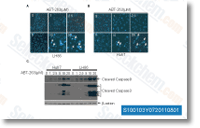In contrast, phosphorylation of Ser727 of STAT3 was unaffected by everolimus therapy in HaCaT cells within the absence of stattic, however, it enhanced somewhat in the presence of stattic. Tyr705 phosphorylation was decreased by deal with ment with everolimus from the presence of pretreatment with stattic. Also, to clarify how STAT3 and mTOR regulate cell toxicity whether or not within a parallel method or within a downstream regulation, we examined if STAT3 action varies in the time dependent manner with therapy of everolimus. Phosphorylation of STAT3 was decreased in quick term but enhanced in long lasting incu bated with lower dose everolimus. Phosphorylation of p70 S6K which is direct downstream of mTORC1 showed inhibition within a time dependent method based upon the mechanism of action of everolimus.
This results show that STAT3 phosphorylation could be regulated indirectly by mTOR. Results of everolimus on MAPKs action in HaCaT cells and effects of MAPK inhibitors on everolimus induced cell growth inhibition in HaCaT cells Prior research demonstrated the PI3K/Akt/mTOR and MAPK pathways represent a cross linked signal net supplier AVL-292 work in numerous cell lines, and that STAT3 is surely an import ant downstream signaling issue of these pathways. Consequently, we confirmed the distinctions within the phosphorylation of JNK, Erk1/2, and p38 MAPK right after remedy with everolimus in HaCaT cells. The phosphorylation of Erk1/2 and p38 MAPK was elevated just after treatment with everolimus in a dose dependent manner in HaCaT cells. Moreover, the phos phorylation of p38 MAPK was specifically enhanced during the presence of pretreatment with stattic.
Figure 5B exhibits the everolimus induced cell development inhibition in HaCaT cells from the absence or presence of a MEK1/2 inhibitor, a p38 MAPK inhibitor or a JNK inhibitor. Treatment together with the p38 MAPK inhibitor decreased the efficacy of cell development inhibition by everolimus MK-2461 in HaCaT cells. A MEK1/2 inhibitor also influence the everolimus induced cell growth inhibition in HaCaT cells, somewhat. Moreover, we examined a chance that MAPKs inhibitors rescue the inhibition of phosphorylation of STAT3 by everolimus. During the pretreatment of SB203580, STAT3 Tyr705 phosphorylation was enhanced comparing from therapy of everolimus alone.
Effects of STAT3 Y705F and STAT3C transfection on everolimus induced cell development inhibition  in HaCaT cells STAT3C is really a constitutively energetic STAT3 that dimerizes consistently by substituting cysteine residues for particular amino acids inside the C terminal loop on the STAT3 molecule, which resulted in the assembly of STAT3 while in the nucleus of transfected cells. Transfection of cells with STAT3 Y705F had a tendency to enhance the cellular toxicity of everolimus in contrast with transfection with an empty vector, but STAT3C had a tendency to alleviate, as shown in Figure 6A.
in HaCaT cells STAT3C is really a constitutively energetic STAT3 that dimerizes consistently by substituting cysteine residues for particular amino acids inside the C terminal loop on the STAT3 molecule, which resulted in the assembly of STAT3 while in the nucleus of transfected cells. Transfection of cells with STAT3 Y705F had a tendency to enhance the cellular toxicity of everolimus in contrast with transfection with an empty vector, but STAT3C had a tendency to alleviate, as shown in Figure 6A.
SiRNA Library
Mitosis is part of the cell cycle.
